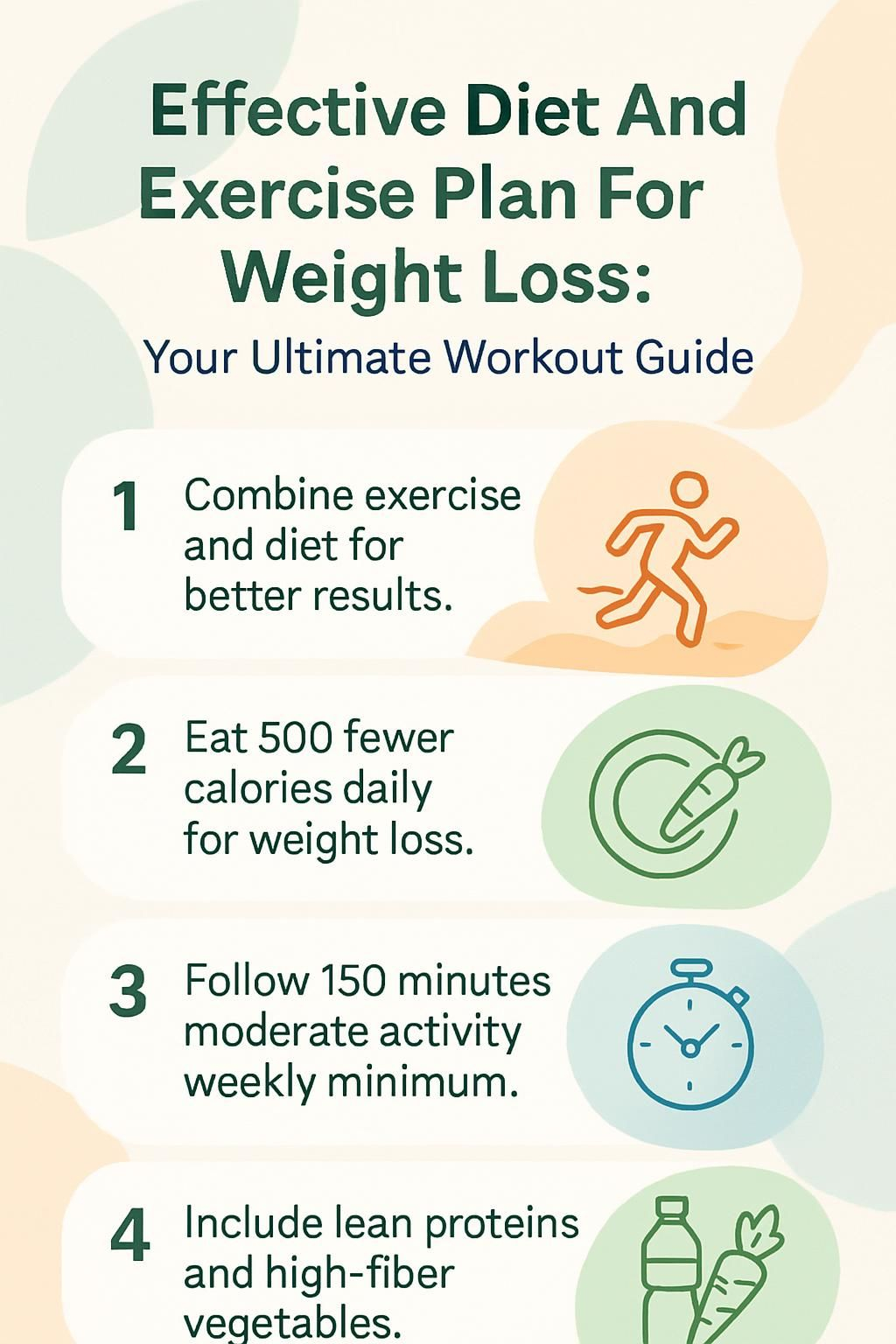Effective Diet And Exercise Plan For Weight Loss: Your Ultimate Workout Guide
Our Nutrition Assistant AI Suite will transform your body. You will lose fat, get toned, and build muscle. Gain confidence and optimal health.
Finding a diet and exercise plan that helps you lose weight can feel confusing. The good news is clear: pairing regular activity with healthy eating improves long-term results compared with dieting alone. This guide turns complex topics like calories, nutrition, and strength training into simple steps you can use today.
You will learn how to create a safe calorie gap, pick foods that keep you full, and build a workout plan for weight loss that fits your life. Start small. Stay steady. Real progress adds up.
Key Takeaways
- Combining regular exercise with a balanced eating plan can double long-term weight-loss success compared with dieting alone, according to CDC and NIH guidance.
- A modest calorie deficit, about 500 calories per day, may lead to roughly one pound lost weekly since about 3,500 calories equals one pound of fat.
- Adults should get at least 150 minutes of moderate aerobic activity or 75 minutes of vigorous exercise weekly for effective weight management.
- Build meals around lean proteins, high-fiber vegetables, whole grains, and healthy fats to control hunger, protect muscle, and lower disease risk.
- Tracking with an app or journal boosts motivation. Mark small wins to strengthen commitment and consistency, as noted by Harvard experts.

Weight Loss Basics Explained

Weight loss starts with how your body uses energy from food and movement. Once you understand the basics, it gets easier to make choices that support a healthy weight.
What is a Calorie Deficit and How Does It Work?
A calorie deficit means you take in fewer calories than your body uses in a day. Your body then taps stored fat for energy, which lowers your body weight.
Cutting about 500 calories per day can lead to roughly one pound lost per week, since about 3,500 calories equals one pound of fat. The CDC suggests a safe pace of 1 to 2 pounds per week using healthy eating plus regular activity.
To estimate your daily needs, find your basal metabolic rate, or BMR, which is energy used at rest. Then add daily movement to get total daily energy expenditure, or TDEE. A simple food-tracking app helps you spot easy swaps, like water instead of soda or whole grain bread instead of white bread.
Weight loss happens when you consume fewer calories than you burn each day, according to the Mayo Clinic Health System.
Why Are Basal Metabolic Rate (BMR) and Total Daily Energy Expenditure (TDEE) Important?
BMR is the calories your body needs for vital functions at rest, such as breathing and circulation. It often accounts for 60 to 75 percent of the calories you burn daily. Age, muscle mass, weight, sex, and genetics all affect your BMR.
TDEE adds calories burned through daily activity, such as walking, workouts, chores, and any movement. Knowing both numbers helps you set realistic goals for fat loss or maintenance. It also helps you personalize your exercise plan and meal plan while lowering your risk for obesity and type 2 diabetes.
Designing an Effective Diet Plan
A strong plan uses healthy habits to move you toward your goal weight. Food choices matter because they shape hunger, energy, and recovery.
How to Balance Lean Proteins, Healthy Fats, and Complex Carbs?
Aim for balanced plates. This supports appetite control, steady energy, and muscle protection.
- Choose lean proteins like fish, skinless chicken, low-fat yogurt, beans, or tofu at each meal to support muscle and fullness.
- Use healthy fats such as olive oil, avocado, nuts, and salmon. These support heart health and hormone balance.
- Pick complex carbs, not sugary options. Favor brown rice, quinoa, oats, beans, lentils, and sweet potatoes for fiber and steady blood sugar.
- Fill half your plate with high-fiber vegetables like broccoli, spinach, peppers, and carrots for low-calorie volume and key nutrients.
- Limit refined carbs and ultra-processed snacks, which can spike blood sugar and add extra calories fast.
- As a simple starting point, many people do well with about 40 percent carbs from whole foods, 30 percent protein, and 30 percent healthy fats.
- Pair carbs with protein or fat to slow digestion and prevent blood sugar spikes that can drive cravings.
- Include milk or fortified plant drinks for protein and calcium, which support bones during training.
- Plan meals ahead to keep variety and consistency. It becomes easier to stick to your weight loss goal.
- Adjust portions based on your activity level and progress using a food or exercise tracker.
Which High-Fiber Foods Should I Include?
Fiber helps you feel full on fewer calories and supports heart and digestive health. Build it into most meals.
- Include whole grains like oats, brown rice, and quinoa. They increase fullness and may lower heart disease risk.
- Add vegetables such as broccoli, carrots, Brussels sprouts, spinach, and cauliflower for bulk and steady energy.
- Snack on fruit like apples, berries, pears, and oranges. They offer fiber and vitamins with few calories.
- Mix in legumes such as lentils, black beans, chickpeas, and kidney beans. Adults should aim for at least 25 to 30 grams of fiber per day.
- Use nuts, such as almonds or walnuts, to add fiber and healthy fats that support heart health.
- Stir chia seeds or flaxseeds into yogurt or smoothies for soluble fiber that supports healthy cholesterol.
- Aim for at least three servings of high-fiber foods daily to support a steady calorie deficit.
After I added more beans and whole grains over four weeks, I felt less hungry between meals and had more energy for aerobic exercise.
How Much Water Should I Drink Daily?
Many experts suggest about 8 cups, or roughly 2 liters, of water per day. Your needs rise with activity, hot weather, or certain health conditions.
If you exercise for at least 150 minutes a week, you may need more fluids. Drinking water before meals can also help you control hunger.
Pay attention to thirst and urine color as simple signs of hydration. Keeping a bottle nearby made my early workouts feel smoother and less tiring.
Why Limit Refined Carbs and Processed Foods?
Refined carbs and processed foods can cause quick blood sugar spikes followed by crashes. You may feel hungrier and eat more than you planned.
These foods are often low in fiber and protein, which makes staying within your calorie target harder. Choosing whole grains and other high-fiber foods keeps your energy steady and supports better weight control.
How Can Meal Planning Improve Consistency?
Planning meals reduces last-minute choices that can derail progress. A weekly menu or meal prep session saves time and supports portion control.
People who plan meals tend to eat more vegetables, fruits, lean proteins, and whole grains. I used to snack during busy weeks, but setting aside Sundays to prep high-fiber lunches and simple dinners improved my energy and kept my habits on track.
Creating an Effective Exercise Plan
A structured routine helps you reach and maintain a healthy weight. It also strengthens key muscle groups and supports heart health.
Why Combine Cardio and Strength Training?
Cardio burns calories during the workout and improves your heart and lungs. Aim for at least 150 minutes of moderate activity or 75 minutes of vigorous activity per week.
Strength training builds muscle, which burns more calories at rest than fat tissue. Adding resistance work can lower body fat percentage faster than cardio alone. Using both methods often produces better weight loss and fitness results.
What Are Functional Training Exercises?
Functional exercises mirror daily movements like squatting, pushing, pulling, and twisting. A squat to overhead press, for example, works your legs and shoulders together.
These moves can improve balance, strength, and coordination. Activities like lunges with rotation or farmer’s walks make everyday tasks easier and reduce injury risk. Many coaches include functional work to help you burn calories while improving useful movement.
[1] Mayo Clinic Patient Education: Functional fitness training, Is it right for you? (2022).
How Should I Start and Progress Gradually?
Start slow to protect your joints and learn proper form. Progress in small steps to stay safe and motivated.
- Begin with three workouts per week. Aim for 150 minutes of moderate cardio, such as brisk walking or cycling.
- Master form before increasing speed or weight. Good technique prevents injuries and improves results.
- Pick low-impact options like walking or swimming if you are new to exercise or have a medical condition.
- After two weeks, slowly add light weights or bands to build lean muscle and support your calorie deficit.
- Track your workouts in a notebook or app to see weekly strength and endurance gains.
- After the first month, consider adding one more session or raising intensity if you feel ready.
- Plan recovery days. Quality sleep and rest help your muscles rebuild and grow stronger.
- Adjust your plan based on how you feel. Talk to your doctor before big changes or if you are considering options like bariatric surgery.
- Stay hydrated during the day. Small sips often work better than large gulps at once.
- Celebrate small wins, such as steady weekly workouts or consistent progress in reps.
During a stressful semester, I tracked simple goals like adding two extra reps each week. That small proof kept me going.
How Do I Schedule Workouts for Consistency?
Put workouts on your calendar like any other appointment. Choose specific days and times you can keep.
Spread your 150 minutes of moderate cardio or 75 minutes of vigorous exercise over three to five days. Pick a regular time that fits your life. Simple checklists or a basic fitness app help you stay on track.
Why Is Recovery Time Important?
Your muscles need time to repair after training. Rest days reduce soreness and injury risk. Pushing hard every day can backfire and slow progress.
Sleep is a key part of recovery. Nutritious meals with protein, healthy fats, and complex carbs help tissue repair. Drink enough water to support joints and muscle recovery. At least one full rest day per week is a smart baseline for most people.
Sample 4-Week Workout Plan for Beginners
This simple four-week plan builds endurance and strength step by step. Paired with healthy eating, many people lose about one pound per week.
What Does Week 1 Look Like for Building Endurance?
Start with three days of brisk walking or easy cycling, 20 to 30 minutes per session. Keep a pace where you can talk in full sentences.
Add two short circuits of beginner bodyweight moves, such as squats, wall push-ups, and step-ups. Do 10 to 12 reps per exercise and repeat the circuit one or two times based on how you feel.
Hydrate before and after each workout. Track sessions in a notebook so you can see steady progress. If you have health concerns, talk to your doctor before starting.
How to Add Strength Training in Week 2?
Keep cardio from week 1, then add two or three full-body strength sessions. Use simple moves like squats, lunges, push-ups, and rows. Start with bodyweight or light dumbbells.
Cover the major muscle groups, including legs, chest, back, shoulders, arms, and core. Research from the American College of Sports Medicine supports at least two strength days a week for building lean muscle.
Rest between sets and sessions to recover well. Mix strength with moderate cardio to support fat loss while building muscle.
How to Increase Intensity with Interval Training in Week 3?
Introduce intervals, short bursts of hard effort followed by easier recovery. For example, walk fast for two minutes, then jog for one minute. Repeat 8 to 10 times.
Start with one or two interval sessions this week. Space them out to help your body recover. Always warm up and cool down to protect your joints and tendons.
How to Combine Cardio and Full-Body Workouts in Week 4?
Pair 20 to 30 minutes of moderate cardio with three full-body strength sessions. Alternate days to allow muscle recovery. For example, do cardio on Monday, Wednesday, and Friday, and strength on Tuesday, Thursday, and Saturday.
Use compound moves like squats, push-ups, lunges, and planks to boost calorie burn. If you feel ready, add short intervals to the last 10 minutes of a cardio session. Drink water throughout every workout.
Foods That Support Weight Loss
Smart food choices make daily habits easier. Aim for simple meals that keep you satisfied and energized.
What Are Good Sources of Lean Proteins?
Protein helps with fullness and muscle repair. Choose options that provide nutrients without too many calories.
- Skinless chicken breast, about 31 grams of protein per 100 grams, is low in fat and easy to cook.
- Turkey breast offers roughly 29 grams of protein per 100 grams and supports strength goals.
- Egg whites have around 11 grams of protein per 100 grams with almost no fat.
- Low-fat cottage cheese gives about 11 grams of protein per half cup plus calcium for bones.
- White fish like cod or tilapia provides around 20 to 24 grams of protein per 100 grams with little saturated fat.
- Nonfat Greek yogurt offers roughly 10 grams of protein per cup and works for breakfast or snacks.
- Tofu gives about 8 grams of plant protein per 100 grams and fits many recipes.
Ample protein helps you stay full longer because it digests more slowly than many carbs. That makes consistent weight management easier.
Which High-Fiber Vegetables Help Weight Loss?
High-fiber vegetables add volume for few calories and support a healthy gut.
- Broccoli has about 2.6 grams of fiber per cup and is easy to steam or roast.
- Brussels sprouts offer 4 grams per cup cooked and contain vitamin C.
- Carrots provide 3.6 grams per cup raw and work well as snacks or in soups.
- Cauliflower delivers 2 grams per cup chopped and fits into many recipes.
- Spinach supplies about 4 grams per cup cooked along with iron.
- Sweet potatoes have roughly 4 grams in a medium potato plus potassium.
- Green peas give about 8.8 grams per cooked cup and boost any meal.
- Artichokes provide around 7 grams per medium vegetable and support gut health.
- Kale offers about 2.6 grams per cooked cup and is rich in antioxidants.
Mix these choices through the week to hit your fiber target and support steady energy.
What Whole Grains Should I Eat?
Whole grains deliver fiber, vitamins, and minerals that support weight management and heart health.
- Oats provide soluble fiber that helps with fullness and healthy cholesterol.
- Brown rice has more fiber than white rice and keeps you satisfied longer.
- Quinoa is a complete protein and supports recovery after training.
- Whole wheat bread includes bran and germ, which provide steady energy.
- Barley is rich in beta-glucan, a fiber that can reduce hunger.
- Bulgur cooks quickly and offers complex carbs for stable blood sugar.
- Millet supplies magnesium and antioxidants that support heart health.
Rotate grains to keep meals interesting while meeting your nutrition goals.
What Are Healthy Fat Options?
Healthy fats support nutrient absorption, hormone health, and lasting fullness. Focus on unsaturated fats most of the time.
- Avocados add monounsaturated fats, fiber, and potassium to salads or toast.
- Olive oil is rich in monounsaturated fat and works for dressings or light sautéing.
- Fatty fish such as salmon, sardines, and trout supply omega-3 fats that support heart and brain health.
- Nuts like almonds, walnuts, and pistachios offer healthy fats and protein for steady energy.
- Chia seeds and flaxseeds provide plant-based omega-3s and fiber. Sprinkle on yogurt or blend into smoothies.
- Dark chocolate with at least 70 percent cocoa gives healthy fats and antioxidants. Enjoy modest portions.
- Peanut and almond butter deliver unsaturated fats. Choose versions without added sugar or hydrogenated oils.
- Sunflower and pumpkin seeds add polyunsaturated fats and crunch to meals.
Using these fats in small amounts makes meals satisfying while supporting a healthy weight.
Staying Motivated During Your Journey
Motivation rises and falls. Simple systems help you stay consistent even on tough days.
How to Set Realistic and Achievable Goals?
Set goals you can measure and reach. A safe pace is 1 to 2 pounds per week, based on CDC guidance.
Break big goals into smaller steps, such as 10 extra minutes of activity per week or one more serving of vegetables per day. Write goals down and give each a target date. Tracking your steps, workouts, or TDEE can keep you engaged.
How Can I Track Weight, Measurements, and Fitness Progress?
Tracking gives you solid feedback. It shows what works and what needs adjusting.
- Use a digital scale once a week at the same time for consistent results.
- Measure waist, hips, chest, arms, and thighs every two weeks to spot body changes.
- Log workouts with exercises, sets, reps, weights, and cardio duration.
- Take monthly photos in similar lighting to notice visual changes.
- Record meals in a nutrition app to monitor your calorie deficit and nutrient balance.
- Note energy and mood during workouts to see endurance and strength improvements.
- Check resting heart rate weekly. A lower number can signal better fitness.
- Pay attention to how your clothes fit as another sign of progress.
Why Celebrate Small Victories?
Small wins build momentum. Hitting three workouts this week or choosing a high-fiber lunch is worth noting.
Your brain releases dopamine during these wins, which boosts motivation to keep going. I enjoyed watching my daily step count rise, even when the scale did not move much. Appreciation eases stress and supports lasting habits.
How Does a Supportive Network Help?
A supportive circle makes consistency easier. Friends or family can join workouts, share meal ideas, and celebrate progress.
People who train with a partner often stick with it more. Community, whether in person or online, reduces stress and helps you stay on track during plateaus.
Important Considerations for Long-Term Success
Two pillars often decide long-term success: quality sleep and stress control. Both influence hunger, choices, and recovery.
How Does Quality Sleep Affect Weight Loss?
Sleep helps regulate leptin and ghrelin, hormones that control hunger. Too little sleep can raise hunger and lead to overeating.
Adults who sleep fewer than 7 hours per night tend to gain more weight than those who sleep 7 to 9 hours. Deep sleep also supports muscle repair and steady metabolism.
What Are Effective Ways to Manage Stress?
Regular activity lowers stress hormones and lifts mood. Try walking, cycling, or yoga for 20 to 30 minutes a day.
Practice deep breathing to calm your heart rate. Keep a sleep routine and make time for hobbies you enjoy. Reach out to friends or support groups if stress feels heavy.
How to Maintain a Sustainable Diet and Exercise Routine?
Set goals that match your schedule. Track food and workouts to spot patterns and adjust early.
Rotate workouts to prevent boredom, such as walking, cycling, and weights across the week. Prep simple snacks ahead of time to avoid impulse choices. Follow the CDC target of at least 150 minutes of moderate exercise per week. If you miss a day, get back to it at the next chance.
When Should I Consult a Doctor or Nutritionist?
Talk to a healthcare professional if you have sudden weight changes, ongoing fatigue, or appetite shifts. If you live with conditions like diabetes, heart disease, thyroid issues, or digestive problems, get guidance before changing your diet or training.
Seek help if your BMI is above 30 and past attempts did not work, or if you feel dizzy during workouts or have persistent joint pain. Expert input protects your health and helps prevent nutrient gaps.
Common Mistakes to Avoid
A few pitfalls can slow your progress. Knowing them helps you stay on course.
Why Is Overtraining Without Rest Harmful?
Skipping rest increases injury risk and slows recovery. Muscles need downtime to rebuild and get stronger. Overtraining can cause chronic fatigue and weakened immune function.
I trained six days a week without rest and developed shin pain that took weeks to heal. Planned rest restored my energy and improved results.
What Are the Risks of Skipping Meals or Overeating?
Skipping meals may slow metabolism and drop blood sugar, which can cause dizziness and cravings. Many people who skip breakfast eat more later in the day.
Frequent overeating strains digestion and spikes blood sugar. Over time, it can lead to weight gain and insulin resistance. Regular, balanced meals help keep energy steady and cravings in check.
Why Should I Avoid Fad Diets?
Fad diets often cut calories too low or remove whole food groups. Early weight loss is usually water and muscle, not fat. Most people regain the lost weight within a year.
Extreme plans can leave you tired and under-fueled for exercise. Small, balanced changes beat quick fixes and protect your metabolism.
How Does Mental Health Affect Motivation?
Stress, anxiety, or depression can lower drive and disrupt routines. People with poor mental health are less likely to stay active or eat well.
If mood changes lead you to skip workouts or overeat, talk with someone you trust or a professional. Support can help you return to steady habits.
Conclusion
Healthy eating plus an exercise plan is a proven path to weight loss. Build meals with lean proteins, whole grains, vegetables, and healthy fats. Combine cardio with strength training to burn calories and protect muscle.
Track your progress, celebrate small wins, and get support when you need it. Stay consistent and patient. Small steps, repeated often, help you reach a healthy weight and keep it.
1. National Institutes of Health (NIH): https://www.nhlbi.nih.gov/health/educational/lose_wt/eat/calories.htm.
2. Centers for Disease Control and Prevention (CDC): https://www.cdc.gov/healthyweight/index.html.
FAQs
1. What is an effective diet plan for weight loss?
An effective eating strategy for losing weight includes a balance of lean proteins, whole grains, fruits, and vegetables. Studies show that reducing processed foods and added sugars helps lower calorie intake while supporting health goals. For example, the Dietary Guidelines for Americans recommend filling half your plate with produce at each meal.
2. How much exercise do I need to lose weight safely?
Experts suggest at least 150 minutes per week of moderate aerobic activity such as brisk walking or cycling. Adding strength training twice weekly increases muscle mass and boosts metabolism according to research from the Centers for Disease Control and Prevention.
3. Can tracking food intake help with weight loss?
Tracking meals can improve awareness of portion sizes and calorie consumption; this often leads to better results in clinical trials. Using a journal or app makes it easier to spot patterns that may slow progress.
4. What are common challenges when following a diet and exercise plan?
Many people find it hard to stay consistent due to busy schedules or lack of motivation; social events can also make healthy choices difficult. Setting realistic goals, planning meals ahead, and seeking support from friends or professionals improves long-term success rates.
Summary: A balanced eating pattern paired with regular physical activity supports steady fat loss over time; monitoring habits helps maintain progress while overcoming obstacles requires planning and support networks.







